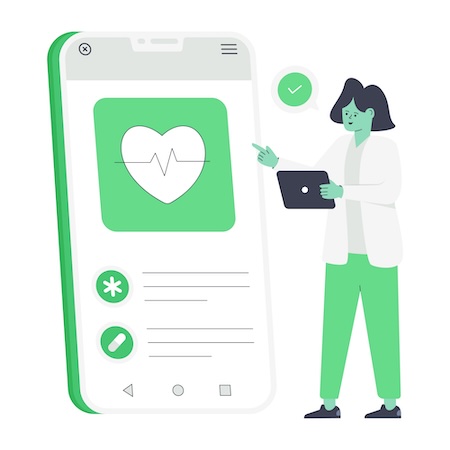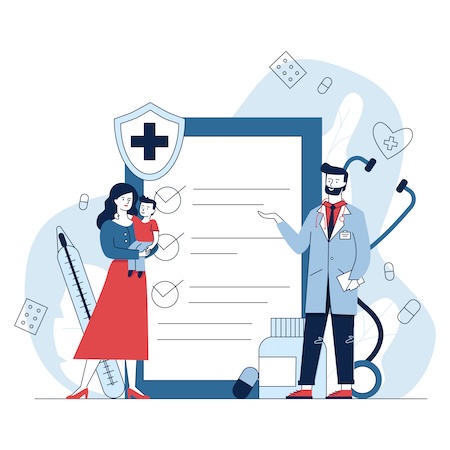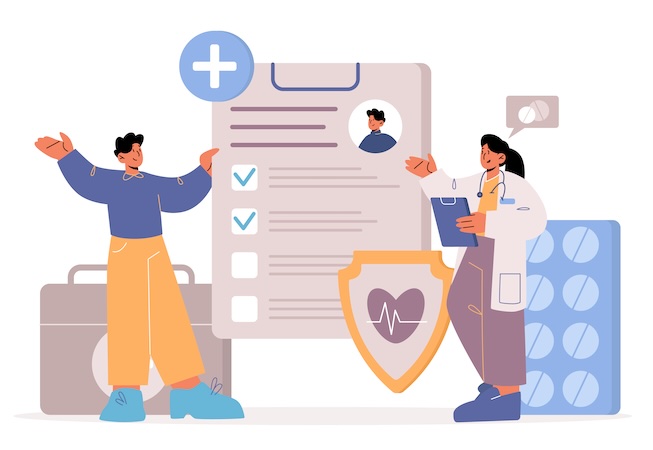In the rapidly evolving world of mobile technology, health insurance apps are at the forefront of a revolution. Bridging the gap between policyholders and insurance providers, these apps offer an unprecedented level of convenience and access to health plan details, claims management, and even teleconsultations.
However, the journey to creating a successful health insurance app isn’t without its challenges, from navigating data-sharing regulations to delivering a user-centric design. But fear not; this blog post is here to guide you through the labyrinth of health insurance app development, providing insights on current trends, key features, and how to overcome potential hurdles.
Top Takeaways:
- The Power of Mobile Health Insurance Apps: With 63.4% of US adults using health apps in the past year, it’s clear that mobile technology is reshaping the healthcare landscape, particularly in health insurance application development. These apps offer a convenient way for customers to interact with their insurance providers, manage their policies, and even consult with doctors remotely. However, they also pose cybersecurity risks, with 88% of health apps capable of collecting and sharing user data. Balancing convenience with privacy is a key challenge that developers must navigate.
- The Benefits of App Development for Health Insurance Companies: Investing in mobile app development offers a myriad of benefits for health insurance companies. It not only provides customers with an easier way to manage their policies but can also give companies a competitive edge in the market. Key features of successful health insurance apps include secure and easy access, comprehensive policy management, 24/7 support, teleconsultation services, and personalized experiences.
Table of Contents:
1. Health Insurance Apps Market Overview
2. Types of Mobile Insurance Apps
3. Benefits of Health Insurance App Development
4. Key Features of a Health Insurance Mobile Application
5. How to Build a Health Insurance Mobile App: 7 Main Steps
- Step 1: Identifying the Purpose and Features
- Step 2: Design and User Experience
- Step 3: Development Process
- Step 4: Integration and Data Management
- Step 5: Testing and Quality Assurance
- Step 6: Launch and Marketing Strategy
- Step 7: Maintenance
6. Challenges to Overcome in Health Insurance App Development
7. How Much Does It Cost to Create a Health Insurance App?
Health Insurance Apps Market Overview
In the burgeoning world of mobile technology, mobile health insurance apps are reshaping the healthcare landscape. These applications serve as a bridge between insurance providers and policyholders, providing immediate access to health plan details, claims management, and even teleconsultations.
They are transforming how we interact with our health insurance providers, making it more seamless and convenient than ever before.
Do Major Health Insurance Companies Offer Mobile Apps?
As we peel back the layers of the health insurance mobile app market, it’s instructive to cast an eye on the major players in the industry. Have you ever wondered whether all leading US health insurance companies offer their own mobile apps, and if they do, how well do these apps cater to the modern consumer’s needs? Let’s take a peek at the top 30 health insurance companies.
You can jump below this table to get our takeaway based on this brief analysis.
Sure, here’s the information organized into a table:
| Company Name | iOS ratings / reviews | Android ratings / reviews | Comment |
| Kaiser Permanente | 2.3 / 1K | 3 / 2K | The rating is for Kaiser Permanente Washington, which has dedicated health plan features. They also have Kaiser Permanente with 4.8 and 4.7 ratings (but virtually no insurance-related features). |
| Elevance Health (Anthem) | 4.8 / 243K | 4.7 / 39K | Meeting modern demands splendidly, their Sydney Health app shines with a 4.8-star rating, claiming the #6 spot in the Medical category across app stores. |
| HCSC | 4.8 / 3K | 4.6 / 552 | Innovation through alliance! HCSC’s partnership with Collective Health boasts a solid 4.8-star app experience. |
| UnitedHealth Group | 4.7 / 272K | 4.5 / 60K | A stalwart in the sector, their application holds an impressive 4.7-star rating and ranks #2 in medical app downloads. |
| Centene | 1.6 / –* | 3.1 / — | A rare miss! Their software has yet to hit the mark, with less than 2-star ratings hinting at an unfulfilled potential. |
| CVS Health Corp. (Aetna) | 4.7 / 260K | 4.7 / 76K | Their well-crafted app isn’t just practical; it’s delightful, evidenced by its 4.7-star approval. |
| Florida Blue | 4.8 / 20K | 4.6 / 8K | A blue ribbon performance sets them apart from the BCBS family with an enviable 4.8-star rating. |
| Blue Cross Blue Shield of Michigan | 4.7 / — | 4.4 / 6K | A bastion of reliability. NB: Not all BCBS insurance apps are like that; e.g. their app for Illinois is only 3.2, and I’ve seen lower ratings for other states. |
| Highmark | 4.1 / 1K | 1.8 / 1K | A mixed bag; users on iOS give it a nod with 4.1 stars, while Android users voice discontent with a lowly 1.8 stars. |
| Blue Cross of North Carolina | 4.2 / 2K | 3.8 / 1K | Steady and functional, they’ve secured a 4.2-star footing. |
| Humana | 2.9 / 2K | 3.6 / 11K | Split perspectives, with Android users offering a 3.6-star rating, while those on iOS are less impressed at 2.9 stars. |
| Blue Cross and Blue Shield of Alabama | 4.3 / 1K | 4.5 / 1K | Scoring high with users. |
| Blue Cross Blue Shield of Massachusetts | 1.7 / 1K | 1.6 / 1K | They have some homework to do, with ratings below two stars. |
| Molina Healthcare | 4.6 / 7K | 4.2 / 2K | A strong contender in the mobile app arena. |
| Independence Health Group | 2.8 / — | 2.2 / 1K | Needing a boost, they’ve room for improvement. |
| CareFirst | 1.2 / 1K | 1.3 / 1K | They’ve pivoted towards mobile web rather than app development. So the app seems like an experiment. |
| Tufts Health | 3.5 / — | 3.1 / — | A reasonable offering. |
| Horizon Blue Cross Blue Shield of New Jersey | 4.8 / 46K | 3.9 / 3K | Their app is a beacon of efficiency. |
| Bright Health | – | – | They’ve stepped out of the insurance game as of January 2024. |
| Blue Shield of California | 4.8 / 21K | 4.1 / 3K | Consistently delivering a high-quality experience. |
| Oscar Insurance | 4.9 / 12K | 4.7 / 2K | Their app is top-notch. |
| Regence | 4.4 / 1K | 2.1 / 1K | A tale of two platforms |
| Blue Cross Blue Shield of South Carolina | 4.4 / 1K | 4.3 / 1K | Scoring reliably. |
| Intermountain Healthcare | 4.5 / 8K | 4.3 / 4K | They boast a healthy reputation. |
| Medica | 4 / — | 1.9 / — | On iOS, they garner a basic 4 stars, but the Android experience lags behind. |
| Priority Health | 1.9 / — | 1.7 / — | With a disappointing reception across both major platforms. |
| Cigna | 4.8 / 125K | 2.6 / 17K | A case of digital divide; higher rating from iOS users. |
| Excellus Health | 2.5 / — | 2.2 / — | They’ve yet to excel. |
| Wellmark | 3.3 / — | 2.6 / — | Maintaining an average stature with a 3.3-star rating, mirroring the familiar BCBS design. |
| EmblemHealth | 1.4 / — | 2.2 / — | Sadly lagging behind, EmblemHealth’s app struggles with user satisfaction, lingering below a 2-star rating. |
* — means an app hasn’t scored more than 500 ratings/votes. Rounding up to the nearest thousand for all ratings.
With a discerning eye on the current landscape of health insurance mobile apps, several compelling takeaways beckon our attention:
- iOS Focus: Isn’t it fascinating how a majority of medical insurance companies prioritize iOS app development, securing higher ratings on Apple’s platform versus Android? The rationale merits exploration—it could be the demographic profile of iOS users or the perceived ease of iOS app development.
- Room for Enhancement on Android: The disparity in software quality between iOS and Android is striking. How can these companies bridge this gap and ensure Android users feel equally valued?
- Comprehensive Experience: The higher-rated applications typically deliver a more comprehensive experience. How might the less-favored software evolve to meet these standards?
- Digital Presence Pays Off: Companies at the top of the list—like Oscar Insurance and Sydney Health—earn their stripes with near-perfect ratings. How significant is the correlation between software quality and company success?
- The Fine Line: A handful of companies can skirt by with subpar apps, but that does not sound like a sustainable approach at all as consumer expectations rise.
These points underscore the pivotal role health insurance mobile apps play in enhancing customer satisfaction and loyalty within the sector. As we’ve seen, there’s a fine balance to strike—failing to invest in a robust digital presence can be a misstep just as detrimental as neglecting a large segment of your user base on platforms like Android in health insurance mobile app development.
The Digital Health Movement Gains Momentum
The digital health revolution is unmistakably upon us, with a tidal wave of users integrating health apps into their daily routines. The embrace of health and fitness technology hints at an undeniable readiness for more sophisticated digital health insurance solutions.
- Widespread Adoption: It turns out that in 2023, over a third of adults in the US don’t merely flirt with health apps; they engage with them frequently, bringing them into their daily lives.
- Youthful Momentum: The surge in mobile health software usage is prominently driven by those aged 25 to 34, showcasing a market ripe for innovation and eager for top-tier digital solutions.
- Gender Dynamics: Interestingly, women lead the charge, representing approximately 75% of health and fitness app users, highlighting a demographic with powerful influence over the direction of healthcare app development.
- People getting used to health apps: nearly two-thirds (63.4%) of US adults have integrated health-related apps into their lives over the past year, as revealed by a survey from Insider Intelligence.
- Surging Installations: Reflect on this — in January 2021, health insurance applications witnessed their most substantial monthly spike in the year, with installations soaring nearly 36% higher than the month before.
While the exact reasons are yet to be fully understood, one thing is crystal clear: health insurance providers cannot afford to overlook the power of an effective mobile app strategy. As this remarkable statistic reveals, users are actively seeking
This sweeping integration of technology into everyday health management underscores not just a trend but a fundamental shift in expectations. As these digital tools become deeply entrenched in the fabric of healthcare, the question is no longer whether health insurance companies should offer a mobile app but how quickly they can evolve these apps to exceed user expectations.
With mobile apps becoming nearly as vital as the cards in their wallets, there is both an immense opportunity and a critical challenge for health insurance providers to step up to the evolving digital demands of their clientele.
Current Trends and Challenges
Navigating through the health insurance market can often feel like a labyrinthine endeavor. But what’s shaping the present and future of this industry?
In the modern healthcare landscape, technology is essential. Recent data shows that 63.4% of US adults used health apps in the past year, highlighting the growing reliance on tech for health management. While these apps offer convenience, they also pose cybersecurity risks. 88% of health apps can collect and share user data, raising privacy concerns amid the healthcare industry’s vulnerability to cyber threats.
These trends create a dynamic environment where innovation in mobile health insurance applications can provide both solutions and competitive advantage. Key insights into the mobile health insurance industry include:
- Accessibility: Health insurance apps provide customers with easy access to their policy details, allowing them to manage their plans and file claims at their convenience.
- Efficiency: These apps simplify complex processes such as claim filing and tracking, leading to increased efficiency and faster resolution times.
- Teleconsultation: Some health insurance apps offer teleconsultation services, enabling policyholders to consult with medical professionals without leaving their homes.
- Personalization: Many apps offer personalized health advice and services based on the user’s health data, leading to more tailored health care.
- Customer Engagement: Through push notifications and interactive features, these apps enhance customer engagement, improving retention and loyalty.
The rise of mobile health insurance apps signifies a shift towards a more consumer-centric approach in the healthcare industry. These applications are not just about providing insurance services; they’re about enhancing the overall user experience.
They empower users to take control of their health, offering personalized advice and providing them with the tools they need to make informed decisions about their healthcare.
Types of Mobile Insurance Apps
As we dive into the world of mobile insurance apps, it’s crucial to recognize that not all apps are created equal. They cater to a broad spectrum of user needs, ranging from the very basic to the highly sophisticated. Let’s explore the different varieties out there:
- Document Management Apps: These apps streamline life by providing a digital platform for managing existing paperwork processes. Users can easily control and access their insurance details, claims, and policy information through a user-friendly mobile app while onboarding and document submission still takes place IRL.
- Health and Wellness Apps: Moving into the digital health realm, these apps don’t just handle your insurance—they actively contribute to your health. They nudge you towards healthier lifestyle choices and personalize health tips based on the data you share. What’s the hook? Insurance companies sometimes sweeten the deal with financial incentives or perks for those who commit to staying healthy.
- Integrated Service Apps: Imagine being able to access healthcare professionals, schedule appointments, and have virtual consultations all through your insurance app. These integrated apps are game-changers in how we think about health accessibility and convenience.
- Data Analytics Apps: These are the tech-savvy apps that insurance executives adore. They provide valuable insights into customer behavior, risk assessment, and policy personalization by analyzing the vast amounts of data generated by users.
When considering the business model, it could involve aggregators such as Mobile Health Consumer, INC., linking health plans, employers, and brokers/consultants, or stem from a single business entity.
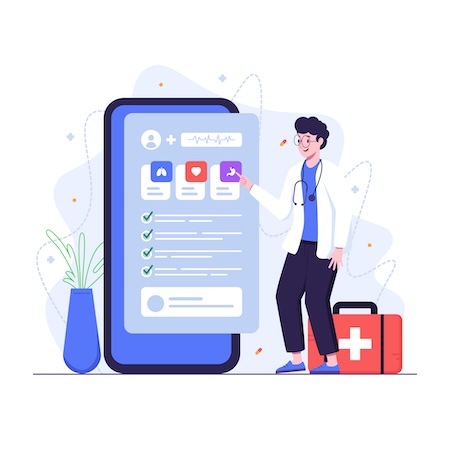 So, how do these apps stand out in the bustling digital marketplace? An app’s success hinges on its ability to engage users by being intuitive, resourceful, and beneficial. It’s not just about what the app does—it’s about how it makes your life easier, healthier, or even more rewarding. Could one of these types play a pivotal role in your next healthcare endeavor?
So, how do these apps stand out in the bustling digital marketplace? An app’s success hinges on its ability to engage users by being intuitive, resourceful, and beneficial. It’s not just about what the app does—it’s about how it makes your life easier, healthier, or even more rewarding. Could one of these types play a pivotal role in your next healthcare endeavor?
Benefits of Health Insurance App Development
The potential advantages of investing in mobile app development for health insurance companies are vast and diverse. They extend beyond the immediate benefit of offering customers a convenient way to access their policies. Some key benefits include:
- Improved Customer Experience: With an intuitive and user-friendly interface, health insurance apps can vastly improve customer experience by simplifying complex processes and providing personalized services.
- Cost Savings: Automating processes such as claim filing and policy management can lead to significant cost savings for health insurance providers.
- Data Collection and Analysis: Mobile apps allow for the collection of a large amount of user data, providing valuable insights into customer behavior, preferences, and trends. This information can be used to enhance services and tailor policies accordingly.
- Better Risk Management: With access to user data, insurance companies can better assess risk and provide more accurate quotes and premiums.
- Competitive Advantage: In a competitive market, offering an innovative and convenient mobile app can give medical insurance companies a competitive edge and attract new customers.
In an age where convenience and control are paramount, to make a health insurance app is to take a definitive step towards blending technological excellence with human-centric service, delivering an app that is a gateway to peace of mind.
Key Features of a Health Insurance Mobile Application
In the realm of health insurance mobile applications, Oscar Health and Sydney Health are two giants that have set a high bar for functionality and user-centric design. Their feature sets highlight the core capabilities that users expect and appreciate in such applications. Let’s dive deeper into these features and see how they can be integrated into your own health insurance app:
- Secure and Easy Access: Both apps offer digital ID cards, enabling users to carry their insurance information wherever they go. This eliminates the need for physical cards and ensures that users can quickly find and access their insurance details whenever they need them.
- Comprehensive Policy Management: The ability to view and manage private policy details is a must-have. Users should be able to understand their share of costs, check what’s covered, renew policies, and track claims – all from the app. Sydney Health does an excellent job at this, providing users with easy access to all their insurance information in one place.
- 24/7 Support: Both Oscar Health and Sydney Health offer round-the-clock support. Oscar Health allows users to message their team with any questions, while Sydney Health offers a 24/7 chat feature. This level of support ensures that users can get help when they need it, improving overall user satisfaction.
- Teleconsultation and Prescription Management: Oscar Health and Sydney Health provide teleconsultation services and prescription management. These features allow users to consult with doctors remotely and manage their medication refills, making healthcare more accessible and convenient.
- Health Tracking and Rewards: An interesting feature offered by Oscar Health is the ability to track steps and earn rewards. It’s a great way to encourage users to stay active and engage with the app. Sydney Health also integrates with HealthKit to pull in data from fitness devices.
- Personalized Experience: Lastly, both apps leverage data analytics to provide personalized experiences. Sydney Health, for example, offers personalized health and wellness information.
Incorporating these key features will equip your health insurance app with the tools needed to deliver a seamless and efficient experience for users. Remember, the goal is not just to provide insurance services, but to engage users, meet their needs, and exceed their expectations.
With these features in place, your mobile app can revolutionize how your clients interact with their health insurance plans. So, why wait? It’s time to harness the power of technology and elevate your health insurance business to new heights.
How to Build a Health Insurance Mobile App: Main Steps
Embarking on the journey of building a health insurance mobile app can seem daunting, but by breaking the process down into systematic steps, success is within reach. Ready to transform your innovative vision into a tangible, user-friendly application that stands out in the health insurance industry? Here’s how to set the wheels in motion:
- Step 1: Identifying the Purpose and Features
- Step 2: Design and User Experience
- Step 3: Development Process
- Step 4: Integration and Data Management
- Step 5: Testing and Quality Assurance
- Step 6: Launch and Marketing Strategy
- Step 7: Maintenance
To develop a health insurance application that truly stands out, you must not only tackle the basic features but innovate beyond them, creating a platform that intuitively aligns with the evolving needs of your tech-savvy customers.
Step 1: Identifying the Purpose and Features
To build a health insurance mobile app that stands out, pinpointing its core purpose is crucial. Ask yourself: What pressing needs can this app address for users? Your app should not only streamline insurance processes but also provide features that empower users in their health journeys. Consider:
- User-Centric Design: Craft experiences tailored to user needs. This includes easy policy access and management functionalities.
- Innovative Solutions: Offer unique features like health tracking that differentiate your app from competitors.
Aligning the app to your target audience’s needs is merely the beginning. As you plot the roadmap for your health insurance mobile app, strategic thinking about feature releases, tech architecture, and financial objectives is imperative. Let’s unwrap these pivotal factors:
- Feature Release Milestones: Planning for phased launches keeps your audience engaged and gives your team clear targets. Think about which features will make a big splash in the market and start with those. What can you deliver quickly that brings immediate value to users? How will you gather and integrate feedback for future updates?
- Tech Ingredients/App’s Architecture: What’s under the hood is as important as the interface your users see. Will you opt for a native, hybrid, or cross-platform approach? How will cloud services play a part in your data management? Your choices here will impact everything from user experience to maintenance costs. Aim for an architecture that’s scalable, secure, and seamlessly integrates with existing healthcare systems.
- Financial Goals: Your software needs to be financially sustainable. How will you balance initial investments with long-term profitability? Your financial planning should align with your company’s vision and market positioning.
Each feature, technological decision, and financial plan you make should bring you closer to the ultimate goal: revolutionizing the health insurance landscape while offering undeniable value to your users.
Step 2: Design and User Experience
Before we solidify our design, it’s critical to embrace the concept of rapid prototyping. Think of prototypes as the testing ground for our innovation – they are the initial models that bring our ideas to life. But why is rapid prototyping a game-changer in app design?
- Interactive Engagement: With a prototype, you can interact with your concept. It’s one thing to visualize a feature, but another to click, scroll, and experience it. Does it feel intuitive? Is it engaging enough?
- User Feedback Loop: By testing with our target audience, we receive invaluable feedback. User testing platforms offer a window into our users’ minds, allowing us to refine and perfect the design based on their real-world interactions and preferences.
- Iterative Improvement: Prototyping is seldom a one-off process. It’s iterative, involving cycles of testing, feedback, and enhancement. With each iteration, the design edges closer to that sweet spot of user satisfaction and business objectives.
Remember, in the vast seas of the healthcare app industry, prototyping is our lifesaver. It keeps us afloat as we navigate through the waves of user expectations and emerging tech trends.
Design can make or break your application. Strike a balance between aesthetic appeal and functionality. Here’s how:
- Intuitive Interface: Design with the user in mind, ensuring that navigation is straightforward and each action feels natural.
- Inclusion is Key: Your app should be accessible to everyone. Include features that cater to users with disabilities.
We share quite a few insights into the intricacies of medical application design in our dedicated blog.
Step 3: Development Process
Your app’s backbone is its technology. Opt for a robust tech stack that ensures:
- Reliable Performance: Your app needs to handle high user volumes without hitches.
- Security First: Since you’re dealing with sensitive information, prioritize data protection from the get-go.
When you partner with a seasoned healthcare app developer, you’re ensuring that your app is not only built on a foundation of industry expertise but is also infused with insights from someone who understands the complex landscape of healthcare regulations and patient needs.
Agile Development is Key
Embrace the agile methodology with open arms. It’s not just a buzzword – it’s your roadmap to an adaptable, user-pleasing app delivered with efficiency. Here’s why going agile is a smart move:
- Flexibility and Adaptability: Agile development is all about embracing changes, no matter when they occur in the lifecycle. Isn’t the ability to refine your app on-the-fly, based on user feedback.
- Focused Deliverables: With sprints, you get to focus on small, manageable chunks of work, providing frequent deliverables. This means your health insurance app improves continuously and visibly.
Insurance services via APIs
When weaving the fabric of your app’s functionalities, consider the powerhouse that is API development. APIs are the unsung heroes, enabling your software to integrate effortlessly with other apps and health systems. Imagine the convenience it would offer your users when your application talks smoothly with their preferred fitness trackers or their doctor’s electronic health records.
HIPAA compliance
Now, let’s delve into something non-negotiable: security. With HIPAA compliance and other security best practices, your app isn’t just an app; it becomes a fortress. Consider robust encryption, secure data transmission, and regular security audits. After all, how can you create a healthcare app without trust as its foundation?
By incorporating these elements:
- Agile Development Practices: An iterative, user-focused approach to development.
- API Development: For seamless cross-application and system integrations.
- HIPAA Compliance & Security Best Practices: To protect sensitive data and ensure user trust.
Related: HIPAA-Compliant App Development Guide
You craft an app that’s not just a tool but a trusted partner in your users’ health insurance journey.
Step 4: Integration and Interoperability
Integration and interoperability aren’t just industry buzzwords; they’re the cornerstone of a frictionless health insurance app experience. Tailor your app for smooth dialogue with existing healthcare systems and insurance databases. It’s about creating a symphony of services that communicate without a hiccup.
Here’s what to zoom in on:
- API Mastery: Your application needs to speak fluently to other services. Develop APIs that not only share data but can also access functionalities from third-party apps and healthcare systems. It’s about expanding your reach without reinventing the wheel.
- Streamlined Integration: Like a puzzle, every piece should fit perfectly. Ensure your app’s compatibility is top-notch for easy data retrieval and sharing. It’s like building bridges between islands of healthcare data.
- Mutual Understanding: Cross-system operability means your app can understand and be understood by other systems with various health data standards. It’s a two-way street that enriches your app’s utility and simplifies user interactions.
Related: EHR Interoperability Guide
With an unwavering focus on these principles, your application transforms into not just an entity but a beacon of connected healthcare, a central hub where health insurance services are integrated with the grace and precision of a well-conducted orchestra.
Step 5: Testing and Quality Assurance
Thorough testing can prevent future headaches. Implement:
- End-to-End Testing: Cover all aspects of the software, from usability to security, before going live.
- Continual Improvements: Post-launch, regularly update your app based on user feedback and evolving technology.
Testing is more than just a phase; it’s a culture we embrace. Imagine this: instead of passing the app to Quality Assurance like a baton, our development and testing teams dance in perfect harmony, testing at every turn. The most successful app projects seamlessly blend development and testing, ensuring issues are caught early.
Step 6: Launch and Marketing Strategy
Visibility is vital. Launch with a bang by:
- Optimized Presence: Use App Store Optimization (ASO) techniques to boost your app’s visibility.
- Targeted Outreach: Focus your marketing efforts on platforms where your potential users are most active.
Ponder the excitement of a launch, but don’t overlook a critical step – navigating the app store waters. Picture your app, pristine and poised, yet a gate to unlock: uploading builds to the App Store or Google Play and smoothly sailing through their rigorous verification processes.
This isn’t just a formality; it’s your app’s initiation to engage eager users globally. An insider tip – kick off your journey in beta waters. Testing your app with tailored audiences can unveil insights not found in the vast ocean of full release. A strategic move, giving your app the opportunity to refine and adapt, ensuring that when it does make an impact, it’s primed to create waves.
Step 7: Maintenance
A successful application requires continuous maintenance and updates to stay relevant. Ensure:
- Smooth Updates: Keep users informed of any changes or new features through regular updates.
- Bug Fixes: Promptly address any bugs or technical issues that may arise.
Let’s not forget the power of automation in maintaining your app’s health. Consider incorporating automatic services that report on user behavior metrics and issues. Now why is this smart?
- Proactive Problem-Solving: By the time a user notices something amiss, you’re already on it. Imagine a world where issues are resolved before they ever become a headache for your users—an app that evolves almost clairvoyantly.
- Data-Driven Enhancements: With real-time user behavior metrics at your fingertips, you can tailor the user experience like never before. It’s like having a crystal ball, revealing exactly where to tweak and enhance.
- Continuous Engagement: Keep your users looped in. When they see that their feedback leads to real, tangible improvements, that’s engagement gold.
By following these steps, you can create a health insurance mobile app that not only meets user needs but also exceeds their expectations. Remember, the ultimate goal is to merge convenience with connectivity, creating an application that not only simplifies but also enhances the health insurance experience.
Challenges to Overcome in Health Insurance App Development
Despite the careful orchestration of development, there’s no denying that challenges loom on the horizon for every health insurance mobile app project.
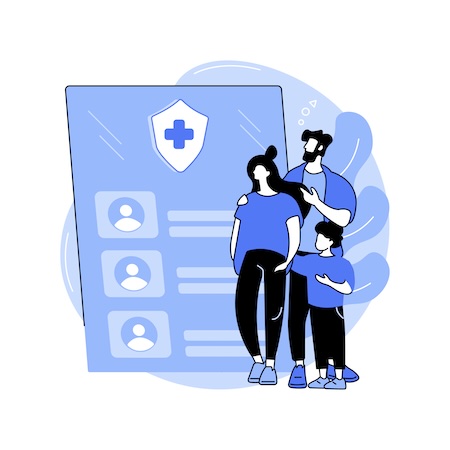
Data-Sharing Challenges and Solutions
One of the biggest challenges in developing a health insurance app is navigating data-sharing regulations and policies. With sensitive personal information at stake, it’s crucial to ensure that user data is protected and shared responsibly.
Here are some potential challenges to consider:
- Legal Compliance: Different regions or countries may have specific laws and regulations regarding the collection, storage, and sharing of personal health information. Ensure that your app adheres to these laws to avoid legal issues.
- Data Privacy: Users want assurance that their data is safe and won’t be shared without their consent. Implement strict privacy policies and secure storage methods to build trust with users.
- Consent Management: Obtaining explicit consent from users for data sharing can be a tricky process. Make sure your application clearly explains what data is being collected and how it will be used, and provide easy options for users to give or revoke consent.
- Data Interoperability: Different healthcare systems use various standards and formats for storing data, making it challenging to create an app that can seamlessly integrate with all of them. Consider using standardized health data protocols to ensure compatibility.
Ethical Use Incentives and Safeguards
While rewarding users for healthy behavior is innovative, it inevitably opens the digital door to possible exploitation. Imagine, for a moment, a user strapping their phone to an energetic dog to rack up ‘steps.’ It’s a humorous image, but it underscores a real challenge.
To safeguard the integrity of our system, we propose layered strategies:
- Anomaly Detection Algorithms: Employ advanced algorithms capable of distinguishing between typical human activity patterns and outliers that suggest deceptive behavior.
- Randomized Check-Ins: Introduce random check-in notifications that require a user’s interaction, making it harder for those with a ‘pet-assisted’ step count to succeed.
- User Education: Foster an understanding that the system’s benefits are rooted in improved health, not just rewards.
Deploying such measures does more than protect our digital ecosystem; it cultivates a culture of honesty. This isn’t simply a preventative measure; it’s our commitment to nurturing an environment where fair play and genuine health progress are paramount. It may seem like a tightrope to walk, yet it’s the balance between incentivization and ethical use that will define the success of our health insurance application.
Here are a few more challenges that can be encountered during health insurance app development:
- Compliance with Payment Regulations: Dealing with sensitive financial data comes with rigorous legal and industry-imposed requirements. For instance, if your app handles card payments, it must comply with PCI DSS. These standards are designed to protect cardholder data and prevent fraud.
- Integration with Existing Systems: Your app needs to work seamlessly with existing healthcare IT systems, including Electronic Health Records (EHRs), pharmacy databases, and hospital management systems. But how do you ensure smooth integration when these systems may use different protocols and data formats?
- Real-Time Updates: Health insurance claims, policy updates, and teleconsultation schedules – all of these require real-time updates for the best user experience.
- Scalability: As your user base grows, your software needs to scale to accommodate more data, more features, and more traffic.
To navigate these complexities and truly excel in health insurance mobile app development, you need to hire a team with the experience and insight that can turn challenges into triumphs; a team that not only understands the nuances of the industry but thrives on innovation and user satisfaction.
Related: How to integrate your medical app with EHR/EMR
How Much Does It Cost to Create a Health Insurance App?
The cost to make a health insurance app is somewhere in the $100K – $200K range for a releasable MVP, depending on a feature set. More details about the cost to develop a healthcare app in our dedicated blog.
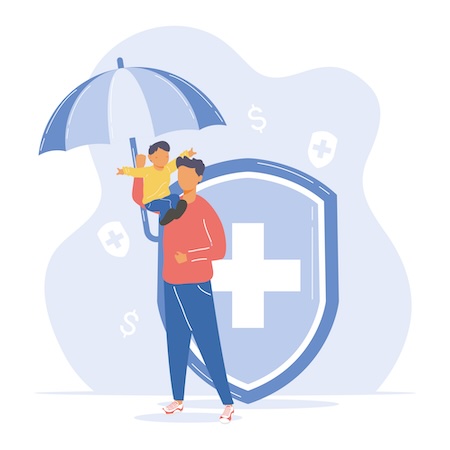
Also Read: App Development Costs Breakdown
How Topflight Can Help
In the competitive space of health insurance app development, we at Topflight have demonstrated our expertise with projects that have significantly streamlined and improved health monitoring and insurance processes. Our portfolio includes a couple of exciting health insurance-related projects:
One was for a venture-funded RPM initiative where we engineered a comprehensive RPM solution. Our role was pivotal in integrating time-based patient metrics into the system, contributing to the treatment of a large population while ensuring scalability for user growth. The solution was further enhanced through integration with an insurance company for RPM reimbursement, providing significant cost savings for patients.
In a separate project, our goal was to boost operational revenues. We overhauled an existing billing system to streamline insurance claims processing. Our expert team migrated the client’s system from AngularJS to the more powerful Angular 5, integrated precise medical billing codes, and developed a user-friendly platform to improve efficiency and accuracy in insurance reimbursements.
These are but glimpses of our capabilities, showcasing our commitment to innovation and excellence in improving healthcare outcomes through intelligent app solutions. Visit our portfolio for more insights into how we’re empowering the health insurance industry with advanced and user-centric technology.
Or get in touch if you’d like to create a health insurance app. We are here to turn your vision into reality, one step at a time.
Frequently Asked Questions
What are the different types of mobile insurance apps?
Mobile insurance apps cater to a broad spectrum of user needs, ranging from basic to sophisticated. Some offer simple policy management features, while others provide comprehensive services like teleconsultations, health tracking, and personalized health and wellness information.
What are some challenges to overcome in health insurance app development?
Developing a health insurance app can pose challenges around data sharing, user engagement and retention, integration with existing healthcare systems, and compliance with payment regulations and security best practices. However, these hurdles can be navigated with careful planning and a well-defined strategy.
How much does it cost to create a health insurance app?
The cost of creating a health insurance app can vary greatly depending on the feature set and complexity of the app. However, an MVP (Minimum Viable Product) can cost between $100K-$200K.
